
ARTWORK
Expressive, distorted and chaotic, Amy-Jean Muller’s ability to depict emotion and fury through her mark making not only creates frenetic line work, but a complex treatment of the canvas too. She explores the surface through gesture to build up the layers as a form of performance art in itself. Images are created using both mixed media and digital processes.
Traditional formats begin their process with the collection of materials and objects that are incorporated into the canvas, while digital depictions are layered through shape and the peeling away of images to the bone. She draws references from mythology, religion, and culture, where the process of artmaking becomes a form of a catharsis or ritual in itself. Rejecting the photorealistic form for abstraction and expression, her work poses questions, confronts beliefs and yearns for the viewer’s discomfort.
Swan Song Series
Sadness Dies in a Swan Song
As part of the final volume of Outcast Press Poetry, Sadness Dies in a Swan Song, which was created and curated over 12 volumes, the final volume explored all relevant themes encountered in each issue. In included in the final issue all Outcast Press Poetry winners to provided a short statement on what writing, the writing community, poetry, and creativity meant to them. One of the intimate reflections was to memorialise their work and themselves in a personalised illustration as part of the theme. Each poet’s image was recreated together with a short quotation from their winning poem.
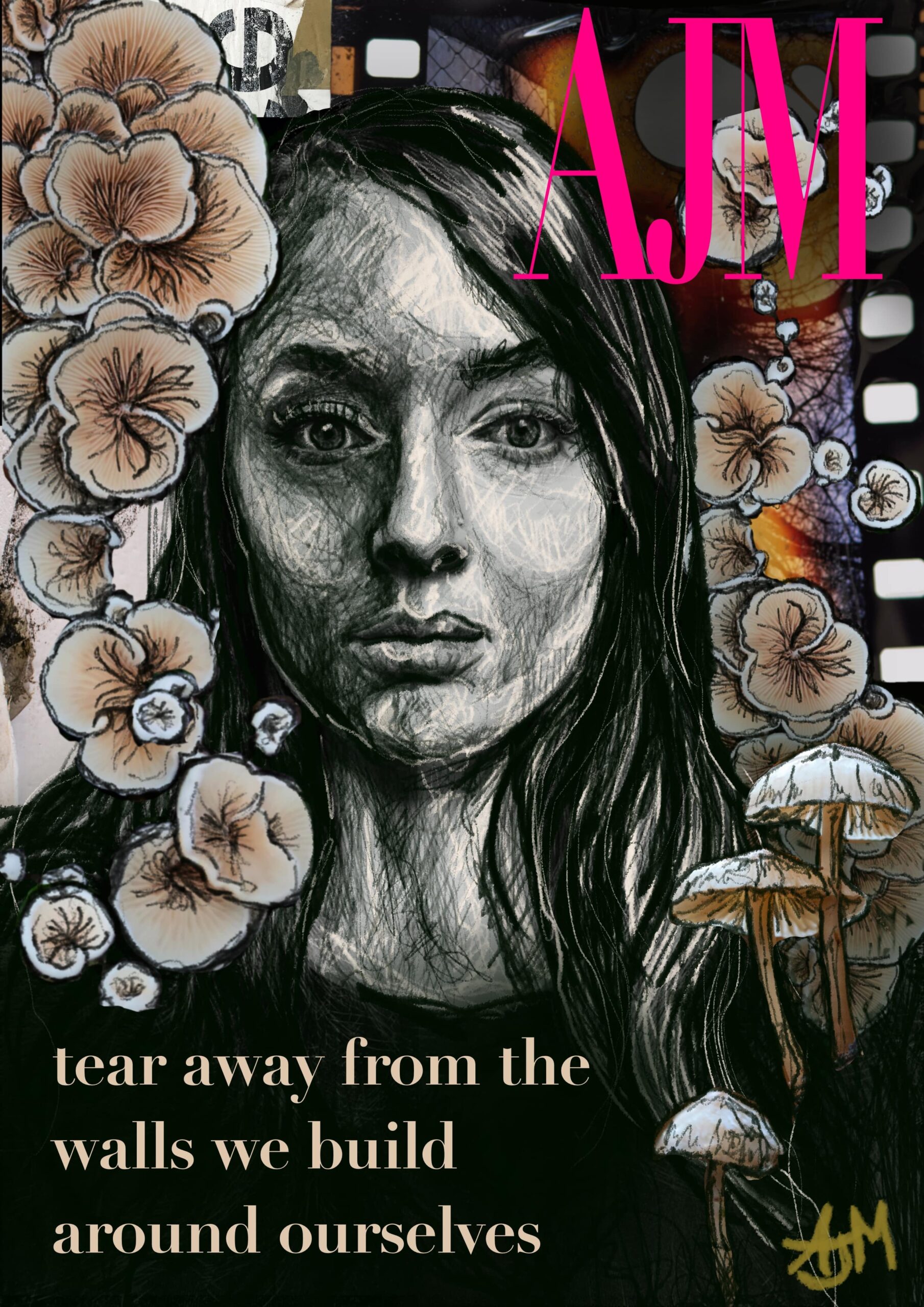
Comprised of symbolic imagery the issue looked at the process from which poetry arises from the pain that formed part of each piece. Themes merged into iconographic posters that tear away from the walls we build around ourselves. Patterns of words are memorialised through reflections as they are pulled from the foundations of our existence – seemingly no longer a part of who we are, they embroider themselves on pages through the etching of bold magenta. The volume looked at the words we create in our darkest moments as emblematic token to the significance of the darkness from which they arose. The truth our our anguish dissipates behind the monuments of who we are, who we were, and who we were meant to be.
This issue looked not only at that pain we endured, but the resurrection of our hope. We take heed of what lies beyond our sorrow and releases what was taken from us in our bleakest moments. When sadness dies, it isn’t forgotten, it isn’t undermined, it simply forgets its attachment to us and who we were. Through this we recognise the bringing forth of a new life – because we shared it, because we felt it, and because we leave it behind. Like mycelium emerging from nothingness, our hope arises from being more as our identity endures from mattering more.
Interview featured in:
Scott Cumming – ‘Falling leaves & flightless birds’ Volume 2 and ‘Sight obscured by snow’ Volume 9
HLR – ‘Weeping Worlds and Paper Shelters’ Volume 3
Jason Melvin – ‘Ships Wrecked on Skin’ Volume 4
Katy Naylor – ‘When love buries you’ Volume 5
C.W. Blackwell – ‘Still Life in Decay’ Volume 6
Bren Booth-Jones – ‘The future we once had’ Volume 7
Hugh Blanton – ‘Hung out to dry’ Volume 8
Michael Pollentine – ‘Descent adorned with bone’ Volume 10
Daniel Shulz – ‘Carved clay weeping flowers’ Volume 11
Maria Barnes – ‘Sadness dies in a swan song’ Volume 12
The Anointing Series

The Anointing Series
The Anointing Series uses various references from religious iconography and repositions them to redefine the meaning of trust, betrayal, power, and secrecy. Mary of Bethany is known for having washed Jesus’ feet with perfume and dried them with her hair. Jesus had noted the anointed feet had prepared him for his burial, which was a poignant premonition to the impended doom of his death. Mary Magdalene is known for bearing witness to the crucifixion, burial, and resurrection of Jesus. She was the first to witness the empty tomb on her way to anoint his body. The empty tomb would be proof of his resurrection, and proof of hope.
Anointing
In the work Anointing, Mary of Bethany, (known as the ‘sinful woman’) stands with Mary Magdalene in a gruesome scene. Mary of Bethany and Mary Magdalene form part of anointing in two ways; one to anoint Jesus before and another to anoint Jesus after his death. The women’s faces are celestial and pure, they are calm and angelic with halos. This is in stark contrast to the brutality of plucking and grasping a cockerel.
Mary Magdalene and Mary of Bethany hold the cockerel which is believed to have crowed three times upon Jesus’s death. In the scene we do not know if the bird has already called or was preparing to call. This calling would mark the betrayal of Peter on his third denial of Christ.
There is no depiction or reference to Christ, ‘the saviour’ in the scene but it is inferred through the holy depiction of the women. The viewer is aware of the calamity, but Mary has not yet found the empty tomb and there is no proof of the afterlife.
The intention to anoint Jesus body would not be planned. The work brings Jesus’ premonition of death to life, and provides a juxtaposition between the act of purity and murder in the scene.

The Premonition
The cockerel acts as a symbol to renounce darkness by calling in the light of day. The cockerels battle in the scene represents two parts of a humans identity. This is a symbol of the premonition to the act of the Mary’s plucking, choking, and throat cutting. They aim to silence him, unaware if he has called Peter’s betrayal already. This reinforces the dynamic between both denial and betrayal and destroys the Christ-like promise that good will overcome evil. The call of repentance is smothered in the brutal act of murder.
Mary Magdalene
Having witnessed the crucifixion, burial and resurrection in the empty tomb Mary Magdalene would be the first to know his resurrection absolved our sins. Yet she takes the blood to anoint him instead. The work implies we are sinners driven by idealistic world views and feeble perceptions. Our human failure lies in our assumption of perfection without sin where politics becomes the chapel of social worship and salvation to our fate. The brutality asks not necessarily what should have been done, but what are we capable of doing.
Mary of Bethany
For Mary of Bethany we see a similar contrast. Having washed Jesus’ feet with perfume and dried them with her hair as a preparation for his burial, the blood spilled by the bird becomes the perfume with which Jesus’ body and feet would be washed. The blood anoints the brutality, and baptises the animalistic nature of humanity. The nihilistic view reinforces that we are doomed by power and destruction, where our futures become affected by manipulation.
The Restraint Series

Restraint Series
The concept of restraint comes from the old French feminine ‘restreinte’ meaning to be held back. The series of works acts to depict the relationship and action between being restrained and being set free. This implies conflict between restraining, tying, holding down and releasing. We are unsure as viewers if the scene illustrated a moment when the participants are being set free or being bound up.
The work deals with female identity and the restraints within society. The perception that women should be seen, and not heard is signified only through their nakedness, while their screams depict the release from being kept quiet. Their faces are covered while their eyes are blacked out to create ambiguity and minimise their identity similar to crime scene photographs. The act of unwrapping through the support of other women indicates a push against patriarchal ideology and reinforces the the need to uplift the female voice. Their anonymity references both support from the ‘other’, as well as support from the inner self.
Shroud
Four woman stand together in ‘Shroud’ where we are unable to distinguish between the perpetrators and participants. We question our perception of fear as they are both anonymous and powerful. We see their strength as both a force of liberation and an act of potential violence.
‘Show’ depicts a moment between two women. We assume the relationship depicts perpetrator and victim. Their intimacy depicts a moment where trust can be achieved through the loss of control. The action is both formidable and liberating, this is reinforced by the scream from the participant and the whisper of the perpetrator. ‘Games’ illustrates the relationship and intimacy experienced durning the act of being tied up and restrained. There is anonymity in the action and pleasure in the embrace. The work ‘Pull’ depicts the idea of force. We are unsure if we are faced with the release or silencing of the participant. There is fear in the removal of the shroud together with pleasure in the intimacy of a soothing touch.

‘Sack’ depicts the release from our isolation and loneliness in the face of vulnerability. The woman either cries or screams at the realisation that she has a choice to no longer be a participant. She is in control of her own uncovering where we consider the nature of choice in both being silenced and taking off the shroud which shields our own power.
Anti Trump Creative Debuts Exhibition

Anti Trump Art Exhibition
As part of the Creative Debuts Trump Exhibition held in London, the ‘Feast of Herod’ depicts a reconstruction of the Baroque painting by Onorio Marinari 1680 ‘Salome with the head of John the Baptist.’ The interplay gives reference to current American political power dynamics. Trump is seen presented with his own head on a platter at a feast where he will ultimately consume himself. We question if he orders the beheading of his ego for consumption, just as the traditional image depicts Salome’s order to behead John the Baptist. The woman represent Judgment and Liberty. Their eyes are cast from the scene, unable to comprehend the moment where Trump eagerly awaits being presented with the prize of his own self.
Voyeurs Exposé Exhibition
Voyeurs Exposé
The triptych called the ‘Voyeurs exposé’ looks at the relationship between the observer and the observed. There is a dichotomy between that which is ‘given or shown,’ and that which is ‘seen and discovered.’ The viewer take on either relationship and are integral in the meaning of the piece. The work asks us to consider who we are in relation to others. Through this observation there is an interplay. We question who is controlled and who is in control. The inclusion of leather and skin implies both restraint and dominance. The complexity of our perception is shaped through a process of layering. The power of the feminine is positioned in such a way that she both shows and reveals that which is hidden from a position of power rather than a coquettish display.
(Featured part of the series Nutritiously Nicola aired 2018)
Becoming Series
Becoming Series
The ‘Becoming Series’ explores the layers of our maturation towards the primal self. The inclusion of the pulling away of flesh and tone acts as a metamorphosis through the stripping away of our identity. The octopus is by nature a solitary creature whose female is a powerful and dominating figure. She often cannibalises her mate in the act of mating to create life. The stripping away refers to the act of one pulling one’s own consciousness back to the primal truth of our female being. The ‘Becoming Series’ explores the layers of personal identity through the inclusion and interplay of shape, application, colour, and stroke. The Becoming Self illustrations incorporate animation which further reinforce the process of transition and the unfolding of who we are at our core.
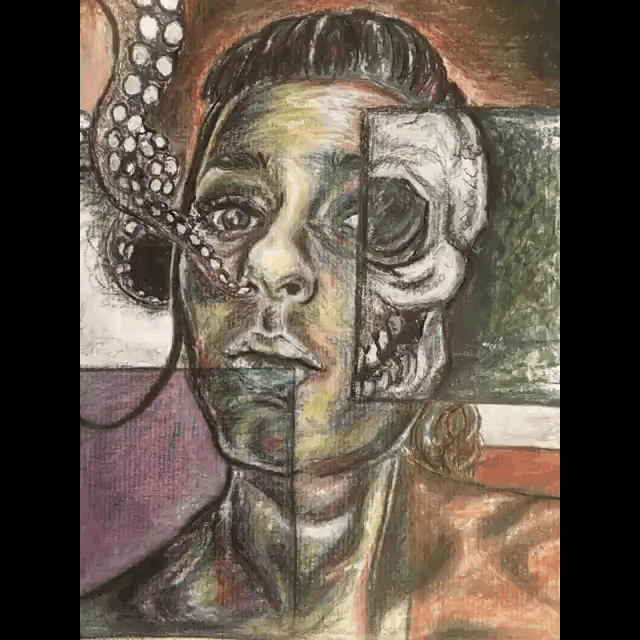
Becoming Exhibition Metamorphosis
The ‘Becoming Series Metamorphosis pieces are comprised of ‘Hold’, ‘Confront’, ‘Spread’, ‘Recline’, ‘Feel’ and ‘Recline’ and explore the pulling away of the layers of ourselves through a personal shedding which emerges as a powerful symbol for the nature of our true identity.
Boys Won't Cry Series
Boys Won’t Cry
The artworks which form part of ‘Boys Wont Cry’ look at the relationship between masculine emotion and masculine identity. The theme explores how both exist in flux. This conflict is based on what is believed to be inherently characteristic of male energy (stoic strength) and how emotion is likened to a softening of what it truly means to be a man.
The works explore what identity means when connected to emotion. Images are layered and blackened to anonymise the individuals while bone and flesh are exposed as they are stripped down to their emotions. The subjects reveal the masking of indoctrination and the personal bondage within themselves. The subjects are positioned in thought and contemplation around the social belief that men should be men. They are both vicim to their environments and themselves. Unable and unwilling to expose their pain, the act of stripping away exposes the reality of their own personal resistance. This choice and dilemma is based on survival and is explored through three themes, Relent, Regret, and Forget. These themes attach themselves to the implicit belief that emotion is weakness. They choose to believe, ‘Boys Won’t Cry’
Boys Won’t Cry: Relent
‘Relent’ reinforces the themes around the act of softening. The subject’s pose appears to be relaxed yet upon closer inspection he is seated within a tight and awkward position. The restricted composition implies a suffocation within his environment. He closes himself off to protect the remaining parts of himself . The title suggests either a yielding is to the core of his emotional truth, or to the environment within which he exists.

Boys Won’t Cry: Regret
The subject shields himself and his gaze from the viewer. His gesture implies shame at having been reduced to his emotions through his unmasking. Seemingly giving way to his emotional identity, he is overcome with regret at having pushed against the notion of masculine power.

Boys Won’t Cry: Forget
The subject is positioned within an environment which appears to be in conflict. Standing in profile, the stance is reminiscent of mugshot photos. He accepts his environment out of guilt from having stripped away most of his control. The title implies the surrender of himself to his emotion or to the social construct of his assumed power.

Fragments Series
Fragments
Fragments explores the relationship with self and mental health from a masculine perspective. As the title suggests, the deterioration of mental stability can be likened, or akin to a loss of control. This is especially true when considering the relationship between masculinity and emotional fragility. The fracturing and fragmentation of self occurs as a byproduct of the affects of masculine toxicity and the patriarchal expectations placed on men. As the male identity is forced into a construct around their roles within society, the belief that seeking support is in fact a form a weakness is implied as a loss of who they are as men. Likened to the female ideology of the fairer sex, this fragmentation is visualised more as a perception of identity rather than a physical softening of their strength. This reinforces the reality that weakness and emotion is not necessarily feminised but intrinsic to male perception.
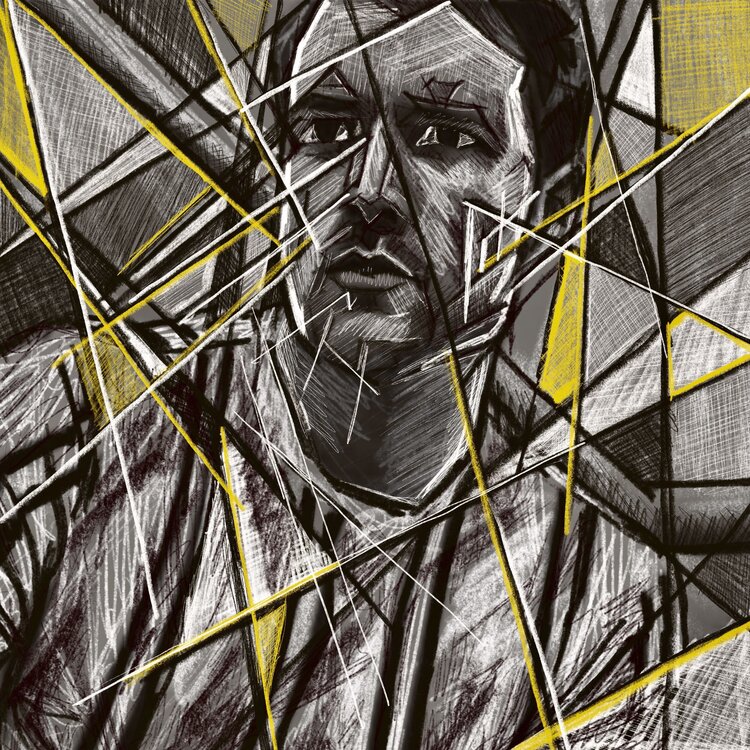
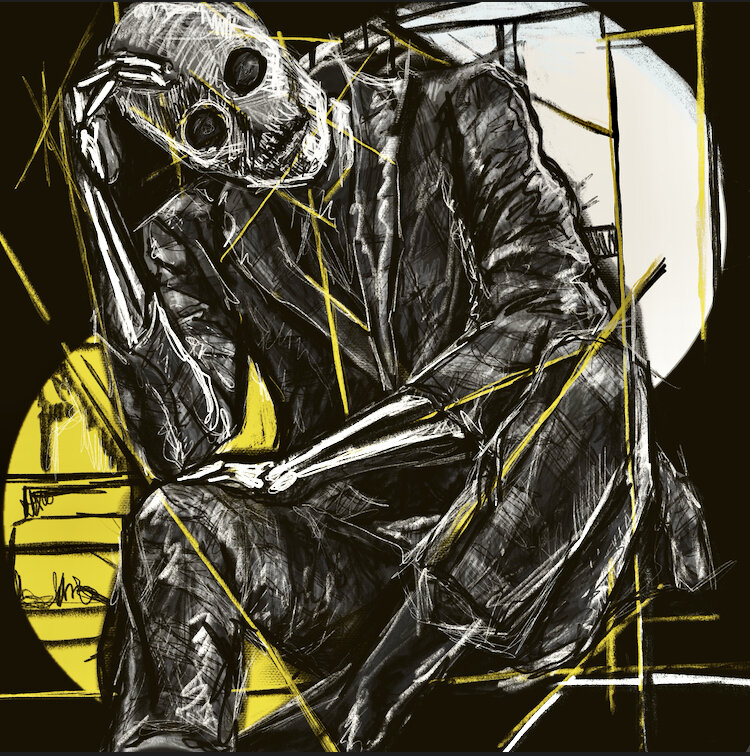
Follow Your Art Exhibition: Victory Series
Victory
Traditional Tibetan Thangka imagery is used in conjunction with a pattered puzzle motif. Indicative of relationships, each puzzle piece reflects aspects of one’s sense of self. Through the seeking of patterns, each piece represents ones understanding of the world and personality. Victory combines the images associated with a triumphant battle against disharmony. Here, 6 traditional enemies, the garuda and snow lion, otter and fish, and crocodile and sea snail are merged to create three mystical animals.
Here harmony is created through the union of opposites (mithun gyulgyal) where rival pairs are joined with heads and bodies to create unique symbols within themselves. The snow lion and garuda form a union with a lions body with a garuda’s head and wings, while a fish joins with an otter, and crocodile chu-srin is combined with a conch shell. These symbols are traditionally placed on victory banners to denote the reconciliation over disharmony.
Coupled with two images of lotus flowers, the symbols become likened to the progression of self, revival, and enlightenment. Lotus flowers reinforce the nature of rebirth and a coming into being. Associated with womanhood and maturation, they anchor themselves in dark waters yet emerge revived. In conjunction with the puzzle motif, the overarching exploration is a reconciliation with oneself and ones identity as a resolution and victory over societies expectations on female identity.
Memory
Memory
The triptych details the disconnection within family in relation to memory. The work explores how one shared history does not equate to a shared reality or experience. The visualisation merges this reality in a singular moment simplified in relation to either a past, present, or future. The central premise of communication plays out as a scene between the subjects. This reinforces how such experiences are essentially fallible once they are relived or communicated again. The telephone lines are absent of wire while juxtaposed to the natural world of crows sharing an experience in silent communication. The concept of communication and perception is further reinforced by the downward gaze. This implies both an unwillingness to see or an ignorance to the impending sense of unease in the central image. The execution of paintwork in the portraiture, appears to be pleasant with the beginnings of a smile, but upon closer inspection, the use of light causes these expressions to become grimace-like. In the central image, we feel a contrast between the material and natural world each stretching away for the subjects towards the other. We are unsure of the landscapes significance between to two subjects, if this is a reflection of the past , a current state of being, or a premonition of an omen to come.
The End Exhibition: The Bardos
The Bardos
Traditional perceptions of the cyclical nature of consciousness and “The Bardo Thodol” form part of the imagery associated with life and death. The ‘Tibetan book of the dead,’ or “The Great Liberation upon Hearing in the Intermediate State” was originally translated by Padmasambhava who brought the text to Tibet in the 8th century AD. The Bardo Thodol is a highly complex text used by Vajrayana/ Tibetan Buddhists in funerary rights, study, and to prepare sentient beings for the transitions into the afterlife through the process of reincarnation for favourable rebirth and liberation.
The Bardo Thodol explains that once consciousness and awareness is freed from the body it creates its own reality. As consciousness dissolves visions occur in various phases (Bardos) which present themselves in wonderful, terrifying, highly symbolized, and confusing ways with aspects of trickery. Overwhelming imagery and visions aim to ignite awareness, which is separated from any physicality in life.
In total there are Six Bardos, the first three relate to consciousness experienced during the life process, thus, begins when one takes birth and endures as long as we live. The second and third are experienced within the dream state and a state of elevated consciousness during meditation. The last three Bardos within the text are represented in the work in 4 ways. Works contain repeated patterns of colour to depict the dissolution of consciousness in circles of energetic colour. Small fine pen motifs depict the energetic consciousness personified as it meets deities, demons, and true realities and fears before reincarnation can occur.
The fourth Bardo (First in focus of the work) occurs at the moment of death, ‘Chikkai Bardo’ which continues through the dissolution or transmutation of the ‘Mahābhūta’ (Sanskrit for ‘great element’) until the external and internal breath has completed. Here an observation of life is met with deities in an 8 pointed wheel.
The fifth (Second and Third focus in the work) is known as the bardo of the luminosity of the true nature or ‘Chönyid Brado’, which commences after the final ‘inner breath’ ( Sanskrit: Prana). This is a highly complex section within the Bardo Thodol, and thus is representative of fears and demonic expressions as the consciousnesses dissolves and unition is created with ones true nature.
The sixth (final focus in the work) is called the bardo of transmigration or becoming, ‘Sidpa Bardo.’ This Bardo endures until the inner breath commences once again to take rebirth or gain Nibbanā (complete dissolution of Samsarā [suffering] or Nirvanā [realisation/enlightenment], thus freedom from rebirth). The inner breath is decided as a new transmigrating form determined by the ‘karmic seeds” or storehouse consciousness of the final phase.
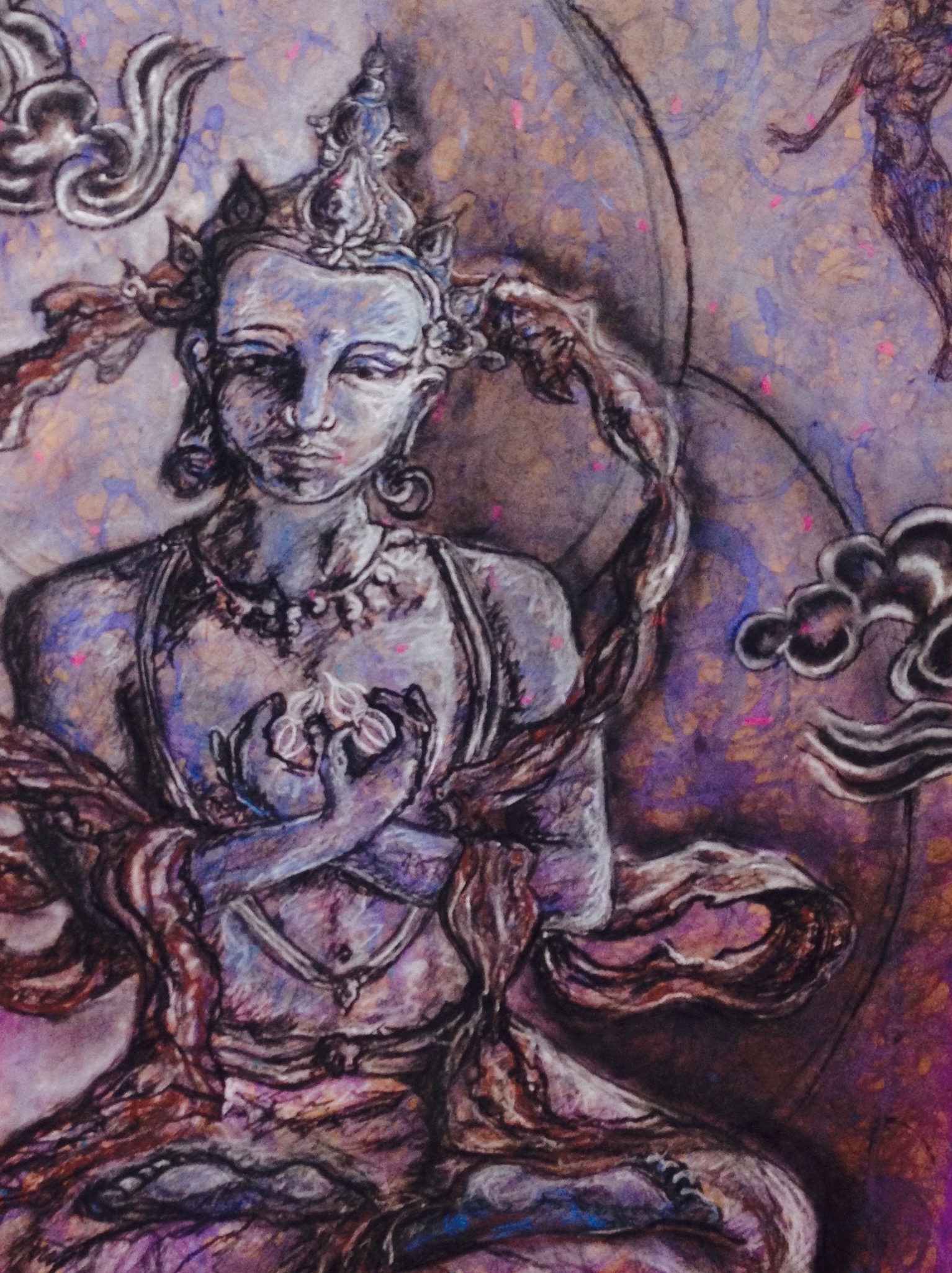
Caution: Children
Caution: Children
Caution Children explores two facets of childhood experiences; Caution: Children Alone and Caution: Children at Play. Each represent a reality in conflict with the perception of what should exist in these spaces. Images are detailed in black and white and mixed media. There is a looming discomfort in the images that leaves the viewer to question that which has just occurred or that which is about to occur. The titles call the viewer to be cautious. Reminiscent of traffic signage to warn motorists to slow down, the titles of the works act rather as a warning to the viewer of what they will see.
Caution: Children Alone
Detailed portraiture rendered in black, white, and grey show the faces of children with harsh lighting appearing to age them beyond their years. The composition is cropped and tight with an awkward intimacy. We are able to see they are children only through their faces as there is no detailed image demoting their size, stature, or identifying clothes. The expressions are fearful and foreboding with eyes that appear to elicit rage and angst. We are unaware of what might have occurred as we are are shielded from any detailed environment with unfinished edges.
The viewer is forced to focus only on the subject. The emptiness between subject and viewer creates a foreboding confrontation while the title Caution; Children Alone, further reinforces this sense of unease. We find ourselves in a confined intimacy that seems to force our eye to view their expressions as adult-like. Once this transition has occurred, the viewer becomes a participant, moving from an observational standpoint to suddenly occupy the viewpoint from the perspective of their perpetrator.

Caution: Children at Play
Large mixed-media pieces are rendered to reflect the spaces children occupy. Unlike the typical cheerful rendering of colour, harsh lines and angles force the viewer to observe empty seats with a voyeuristic quality. The surface is built up with paper, lace, memorabilia, grasses from playgrounds, and hundreds of Bougainvillea petals.
Images of a recoiling boy imply laughter but denote a potential horror. Colour appears to wash over surfaces like rust, calling us to recognise the absence of children on swing sets and in the park. Images appear to float like hallucinations, layered as memories, they feature as a mirage to an event which has just occurred, or is occurring out of frame. The tile suggests caution for the viewer to recognising their absence from the scene, and together with the word ‘play,’ implies their location presents a world far more sinister.
Icarus
Icarus
Based on the Greek myth, Icarus looks at the notion of escape and the rise of heroic daring. The story of Icarus speaks of Icarus’ escape from Crete through the creation of wings attached with wax. Typically associated with the fundamental dangers of male hubris, the work presents a naked woman in partial flight. Created from wax, feathers, found objects and lace, the surface is built up to layer meaning and symbolise items associated with the notions of weaving typically found in Greek myth affiliated with women. Pain is layered over biological illustrations of birds and anthropological imagery and peotry to reinforce the act of flight almost as a talisman.
The work creates a dichotomy between the perception of what would be deemed female hubris at the recognition of pride, self worth, and self confidence at deciding to rise beyond systemic patriarchal structures within society. The dialogue creates and interplay between the perceived notion of pride versus the notion of reclamation. This repositions the works meaning to depict a woman rising for survival beyond the dangers of falling. The notion of falling implies a fall from grace and a fall back into the fundamental structures which hold her on man’s Island to serve the masculine ideology. Rather than falling, the image depicts the rise. The feathers remain in tact against a brutal blackened sky as wax remains solidified, implying the notion of fear is only a perception of ones own misgivings. Icarus laughed as he fell, while the work displays the image of a woman beginning to laugh as she ascends to yell at the winds, spread her arms wide and bare her teeth to the world.

Ethekwini Ngigubani: “Who am I?” Exhibition
Under my Skin
Selected to be part of the Ethekwini Municipality’s Ngigubani: ‘Who and I?” Exhibition with 40 artists, ‘Under my Skin” explores the theme in relation to identity, culture, and heritage and explores the notion of perceived history in line and that which exists below the surface. The surface of the image is built up with texture, line, lace, fabrics and found objects such as twine and dried foodstuffs typically associated with female identity as mother and nurturer. In stark contrast, an explosed coquettish reclining figure, much like a Ruden-esque woman, lies in confrontation with the viewer. Immediate lustful associations are made in terms of identity related to sex and gender.
A paper was produced in conjunction with the piece to explore the notion of nationhood and the feeling of placelessness of white female identity, as well as a perceived history, fault, as perpetrator of the ills of apartheid. Interactive windows open and close to display illustrations which form part of ones history, the detail of parental protests against apartheid and the government, historical associations related to femininity, historical guilt and victim blaming, and the feeling of otherness in line with the subjugation of women. The vier is both an active part of the responsibility of the uncovering of ones identity and understanding of the broader sense of self. This work formed part of Play TV’s review of the exhibition and was aired in South Africa.
Red Eye DAG Exhibition: Natalia
Natalia
For the work titled ‘Natalia’ visual influences stem from isiZulu cosmology and symbols associated with beadwork, religious practices, dress to represent milestones and cultural practices.
KwaZulu Natal as a region appears to rise from primal emotion, having been named on Christmas by Vasco De Gama, associated with Nelson Mandela’s capture in the Midlands, and the Valley of a thousand hills being inspiration to Alan Paton’s “Cry The Beloved Country.” As a region it offers a resting place from turmoil of its past much like a mother nurturing a young child. Anthropological concepts are influenced by ancient Rome, such as, “She Wolf” which creates a dialogue in terms of nourishment and mothering.
Culturally specific concepts affiliated to the maturation ceremony of the Reed Dance, and the phallic association of the reed itself asks the viewer to reconsider areas of thinking in relation to isiZulu cosmology. The inclusion of the Zulu Love Letter and it’s symbolism in relation to communication, value, and relationships is coupled with layered text under paint from traditional songs This action of conflicted thought, and binary opposites in action, forms a dialogue of conflict. Visually the piece is multifaceted, both in construction and meaning. The raw nature of Dali’s “Soft construction with boiled beans” influenced the imagery in terms of nature of things within a locational context.
Natalia includes symbols from the coat of arms in terms of the lion and wildebeest. These two animals are used traditionally to represent the merging of the two areas in KwaZulu and Natal. The wildebeest, a distant cousin of the Cow, contains associations affiliated to femininity, migration, nutrition, nurturing, royalty, economic value etc, while the lion, also know in isiZulu culture to be, “the beast of a thousand omens” is considered a symbol of a transition between two worlds, a representative of judgment, an act to weed out the weak, to be proud or rule. There was an intention to deconstruct the relationship between these two species to recreate a dialogue and force the viewer to reconsider the image. The surface is built up with texture and sand from the region, including race and food stuffs and beads. Natalia nurses a lion and dons horns of the beast, born as the mother of stars, she is the personification of a land ready to rise and confront its tethered past.